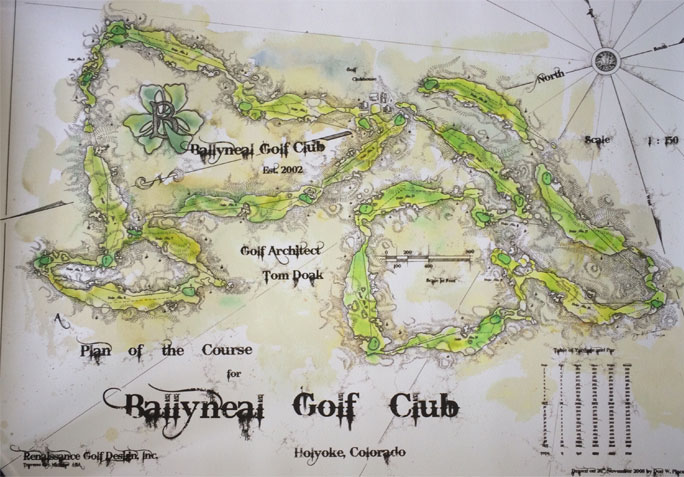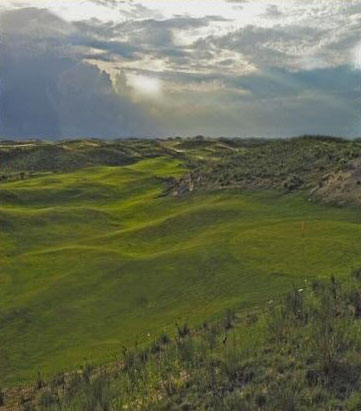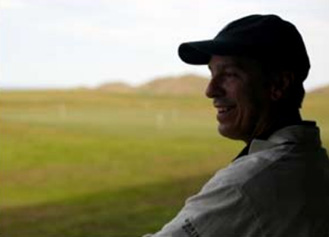Ballyneal History
Circa 1979, Ballyneal was simply a vision of a young, local golf enthusiast, Jim O’Neal. Jim recognized the swath of sand dunes just south of Holyoke that the locals call the “chop hills” as being reminiscent of the dunes in faraway Ireland and Scotland where golf was born. The dream of creating an authentic links course stayed on the back burner until older brother Rupert fanned the flames of creation when he brought up the idea of building a course to compliment the family-owned
hunt club.
 The two purchased 700 acres of land from a local farmer and in 2002 hired Tom Doak of Renaissance Golf Design (who had just finished the highly regarded Pacific Dunes course in Bandon, Oregon). Tom and his Renaissance team studied, discovered and refined the routing for two years before construction finally began in earnest on Ballyneal. Letting Mother Nature dictate the flow instead of forcing the flow was paramount in his approach to routing the course.
The two purchased 700 acres of land from a local farmer and in 2002 hired Tom Doak of Renaissance Golf Design (who had just finished the highly regarded Pacific Dunes course in Bandon, Oregon). Tom and his Renaissance team studied, discovered and refined the routing for two years before construction finally began in earnest on Ballyneal. Letting Mother Nature dictate the flow instead of forcing the flow was paramount in his approach to routing the course.
The fescue sward that defines Ballyneal took hold better than anticipated and Tom Doak struck the first ball in summer of 2006. The course has since matured to become one with the native sage and yucca that abound in the Chop Hills. What’s most striking to players is the variety presented by the combination of the design, the playing surface and the conditions. The fescue surface and the gusty conditions promote true links style golf where a ground game is often the best approach.
The one thing Ballyneal has proven is that a great course will withstand the test of time. Despite the financial headwinds that many private clubs faced in the years following the 2009 recession, Ballyneal emerged with a change of ownership as one of the top destination golf clubs in the world. Its ‘village’ where play starts and completes boasts four lodges in addition to the pro shop, restaurant and reception buildings. They all surround the Commons, a putting complex, where friends new and old meet to swap stories and laugh about the day’s play and the shot that nearly went in.
Meet the Architect, Tom Doak

Every great golf architect has taken the time to study the great links of the British Isles, upon which the game of golf evolved. Thanks to a scholarship from Cornell University, I got to live on the links — caddying at St. Andrews the summer after my graduation, then spending the next seven months playing and studying every golf course of note.
In that year abroad, I discovered a challenging, natural outdoor sport played by all ages, on exciting courses which has cost nothing to build and which were affordable for all to play. Ever since, I have felt a responsibility to build courses which reflect the ideals of the game as the Scots still play it.
My ideas of golf course design are shaped by having seen nearly every great course in the world — more than 1,000 in all. It still fascinates me how different good courses can be from one another. Sometimes a stretch of ground will remind me of a golf hole I saw in Britain twenty years ago, but the best designs of all are organic, evolving from the subtleties of the ground they inhabit. The chance to create an interesting golf hole which is a bit different than anything I’ve seen before is what makes all the travel worthwhile.
I spent three years working on construction projects for Pete Dye and his sons, learning how golf courses are built at the highest level. Along the way I discovered that I love the work, too – being out in the field, refining design ideas while the course is coming together. My first solo design opportunity came at the age of 26, and I haven’t looked back; but we continue to improve at the craft of building golf courses with every project we do.
 I’ve been called a lot more names than most golf course architects. Iconoclastic. Cerebral. A traditionalist, and a radical. I love to be considered a radical, but it’s ironic that we’re also trusted consultants to some of the most conservative golf clubs in America. Most of all, I’ve been labeled as “controversial”, But so, too, were my heroes in the business, Alister MacKenzie and Pete Dye.
I’ve been called a lot more names than most golf course architects. Iconoclastic. Cerebral. A traditionalist, and a radical. I love to be considered a radical, but it’s ironic that we’re also trusted consultants to some of the most conservative golf clubs in America. Most of all, I’ve been labeled as “controversial”, But so, too, were my heroes in the business, Alister MacKenzie and Pete Dye.
Today, our design commissions give us the chance to lead by example. And I’m excited to finally be getting the opportunity to show what I’ve learned.
A Letter From Tom Doak
